
|
acetic acid |
acetic acid is a lipid of Fatty Acyls (FA) class. Acetic acid is associated with abnormalities such as Vitamin B 12 Deficiency. The involved functions are known as Excretory function. The related lipids are Propionate. |
89633 |
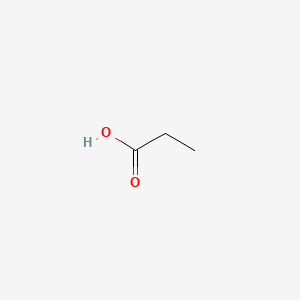
|
propionic acid |
propionic acid is a lipid of Fatty Acyls (FA) class. Propionic acid is associated with abnormalities such as Epilepsy, Infection, Tuberculosis, Alkalosis and Ischemia. The involved functions are known as Uptake, Biosynthetic Pathways, Methylation, Protein Overexpression and Biochemical Pathway. Propionic acid often locates in Body tissue, Cytoplasmic matrix, Membrane, Protoplasm and Extracellular. The associated genes with propionic acid are TRIO gene, TRRAP gene, SLC5A8 gene, SLC33A1 gene and Homologous Gene. The related lipids are Fatty Acids, Propionate, butyrate, Valerates and mycocerosic acid. |
7360 |

|
butyric acid |
butyric acid is a lipid of Fatty Acyls (FA) class. Butyric acid is associated with abnormalities such as PARKINSON DISEASE, LATE-ONSET, Colitis, Autoimmune Diseases, Inflammatory Bowel Diseases and PARAGANGLIOMAS 2. The involved functions are known as DNA Methylation, Transcription, Genetic, chromatin modification, Gene Expression and Gene Silencing. Butyric acid often locates in Membrane, Chromatin Structure, Chromosomes, viral nucleocapsid location and Ribosomes. The associated genes with butyric acid are Locus, Genes, Dominant, Genes, rRNA, Genome and Chromatin. The related lipids are Butyrates, butyrate, Promega, Butyric Acids and Butyric Acid. |
9358 |
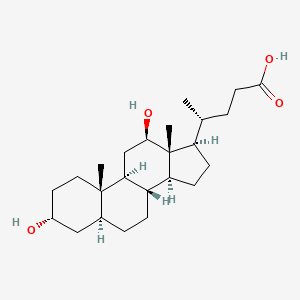
|
3alpha,12beta-dihydroxy-5alpha-cholan-24-oic acid |
3alpha,12beta-dihydroxy-5alpha-cholan-24-oic acid is a lipid of Sterol Lipids (ST) class. 3alpha,12beta-dihydroxy-5alpha-cholan-24-oic acid is associated with abnormalities such as Cholestasis and Little's Disease. The involved functions are known as inhibitors, Signal Transduction, Phosphorylation, Cell Survival and Detergents. 3alpha,12beta-dihydroxy-5alpha-cholan-24-oic acid often locates in Protoplasm. The related lipids are Promega. |
1175 |
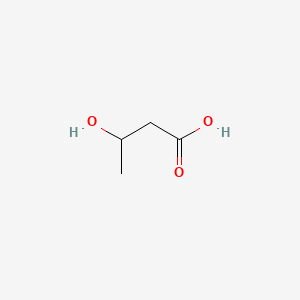
|
3-hydroxybutyric acid |
3-hydroxybutyric acid is a lipid of Fatty Acyls (FA) class. 3-hydroxybutyric acid is associated with abnormalities such as Ketosis. The involved functions are known as fatty acid oxidation, Oxidation, Synthesis, inhibitors and glucose metabolism. 3-hydroxybutyric acid often locates in Blood, Adipose tissue, Protoplasm, Hepatic and Extracellular. The associated genes with 3-hydroxybutyric acid are Genes, Developmental and Oncogene, RET. The related lipids are Fatty Acids, Nonesterified, 6-hydroxyhexanoate, tributyrin, 3-Hydroxyvalerate and Valerates. |
4735 |
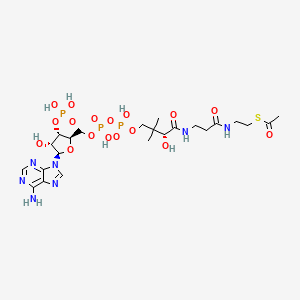
|
Acetyl-coa |
|
1243 |
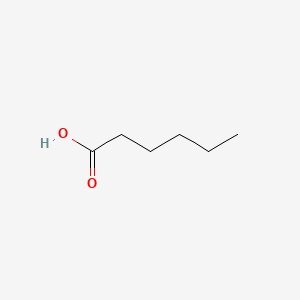
|
HEXANOIC ACID |
HEXANOIC ACID is a lipid of Fatty Acyls (FA) class. Hexanoic acid is associated with abnormalities such as Obesity, Ileoanal Pouches, Ulcerative Colitis, Ulcerative colitis, quiescent and Diabetes Mellitus, Non-Insulin-Dependent. The involved functions are known as Binding (Molecular Function), Anabolism, Adjudication, enzyme activity and Process. Hexanoic acid often locates in Membrane, Tissue membrane, Microsomes, Liver, Microsomes and Mitochondria. The associated genes with HEXANOIC ACID are SH2D1A gene, Fusion Protein and MAPK3 gene. The related lipids are hexanoic acid, Fatty Acids, Butyric Acid, Propionate and Palmitates. |
1028 |
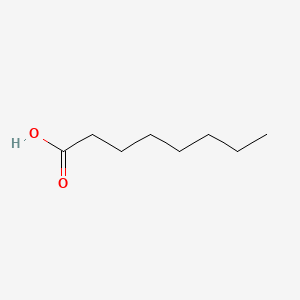
|
octanoic acid |
octanoic acid is a lipid of Fatty Acyls (FA) class. Octanoic acid is associated with abnormalities such as Ischemia, Diabetes Mellitus, Non-Insulin-Dependent, Diabetes, Cardiomyopathies and Obesity. The involved functions are known as Anabolism, 5-(carboxyamino)imidazole ribonucleotide mutase activity, Citric Acid Cycle, Metabolic Inhibition and Excretory function. Octanoic acid often locates in Pore, Protoplasm, Endothelium, Mitochondria and Muscle. The associated genes with octanoic acid are P4HTM gene, CPT1A gene, HADH gene, ACSL1 Gene and CD36 gene. The related lipids are Fatty Acids, Nonesterified Fatty Acids, Oleates, Palmitates and hexanoic acid. |
3349 |
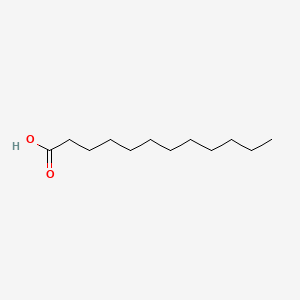
|
lauric acid |
lauric acid is a lipid of Fatty Acyls (FA) class. Lauric acid is associated with abnormalities such as Infection, Renal tubular disorder, Hypertensive disease, Obesity and Mycoses. The involved functions are known as Transcription, Genetic, Signal Transduction, Mutation, metaplastic cell transformation and Anabolism. Lauric acid often locates in Skin, Plasma membrane, Cytoplasmic matrix, Body tissue and Palmar surface. The associated genes with lauric acid are Gene Family, SLC33A1 gene, Homologous Gene, Open Reading Frames and P4HTM gene. The related lipids are Fatty Acids, Oleic Acids, Palmitates, Stearates and 9,11-linoleic acid. |
3691 |
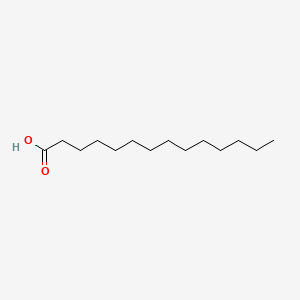
|
Tetradecanoic acid |
Tetradecanoic acid is a lipid of Fatty Acyls (FA) class. Tetradecanoic acid is associated with abnormalities such as Chronic lung disease, Infection, Spastic syndrome, Diabetes and Cardiovascular Diseases. The involved functions are known as Fatty acid biosynthetic process, Anabolism, lung alveolus development, 5-(carboxyamino)imidazole ribonucleotide mutase activity and Homeostasis. Tetradecanoic acid often locates in Structure of parenchyma of lung, Blood, Head, Membrane and Cytoplasmic matrix. The associated genes with Tetradecanoic acid are SLC33A1 gene, SFTPA1 gene, P4HTM gene, Polypeptides and GPR132 gene. The related lipids are Fatty Acids, Nonesterified Fatty Acids, palmitoleic acid, Phosphatidylglycerols and Butanols. |
5058 |
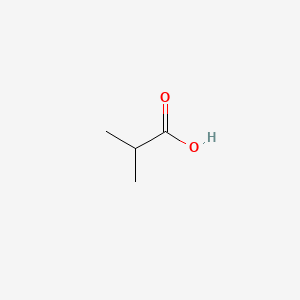
|
ISOBUTYRIC ACID |
ISOBUTYRIC ACID is a lipid of Fatty Acyls (FA) class. Isobutyric acid is associated with abnormalities such as Atrophy, Muscular, Spinobulbar. The involved functions are known as Signal Transduction, Oxidation, Vmax, Metabolic Inhibition and Regulation. Isobutyric acid often locates in Cytoplasm, Plasma membrane, peroxisome, Mouse Embryonic Fibroblast and Protoplasm. The associated genes with ISOBUTYRIC ACID are Candidate Disease Gene, CDKN1A gene, MYC gene, E2F1 gene and HBP1 gene. The related lipids are butyrate, Butyrates, lipid structure, Fatty Acids and Propionate. The related experimental models are Knock-out. |
762 |

|
Arachidonic acid |
Arachidonic acid is a lipid of Fatty Acyls (FA) class. Arachidonic acid is associated with abnormalities such as Atherosclerosis, Ischemia, Hypertensive disease, Hypertension induced by pregnancy and Vascular ring of aorta. The involved functions are known as Platelet aggregation, Anabolism, Ion Transport, Signal Transduction Pathways and Signal. Arachidonic acid often locates in Extracellular, Body tissue, Protoplasm, Tissue membrane and soluble. The associated genes with Arachidonic acid are CYP2J2 gene, CYP2E1 gene, Recombinant Proteins, POR gene and P4HTM gene. The related lipids are Fatty Acids, Glycerophospholipids, Steroids, octadecadienoic acid and 9-hydroxy-10,12-octadecadienoic acid. The related experimental models are Mouse Model and Knock-out. |
22864 |

|
Leukotriene b4 |
Leukotriene b4 is a lipid of Fatty Acyls (FA) class. The involved functions are known as Chemotaxis, release of sequestered calcium ion into cytoplasm and Polymerization. Leukotriene b4 often locates in Protoplasm. The associated genes with Leukotriene b4 are phallacidin. |
9311 |

|
Linoleic acid |
Linoleic acid is a lipid of Fatty Acyls (FA) class. Linoleic acid is associated with abnormalities such as Diabetes Mellitus, Non-Insulin-Dependent, Metabolic syndrome, Obesity, Chronic Obstructive Airway Disease and Pneumonia. The involved functions are known as Insulin Resistance, Inflammation, Synthesis, Pathological accumulation of air in tissues and cytokine biosynthesis. The associated genes with Linoleic acid are TNF gene, CCL2 gene and TLR4 gene. The related lipids are palmitoleic acid, nervonic acid and Sphingolipids. |
5699 |

|
Linoelaidic acid |
Linoelaidic acid is a lipid of Fatty Acyls (FA) class. Linoelaidic acid is associated with abnormalities such as Obesity, Diabetes Mellitus, Non-Insulin-Dependent, Pneumonia, Chronic Obstructive Airway Disease and Metabolic syndrome. The involved functions are known as Metabolic Inhibition, Steroid biosynthesis, Signal Transduction, Insulin Resistance and Inflammation. Linoelaidic acid often locates in Mitochondria, Membrane and Cytoplasmic matrix. The associated genes with Linoelaidic acid are FFAR1 gene, C9orf7 gene, TNF gene, CCL2 gene and TLR4 gene. The related lipids are Fatty Acids, octadecadienoic acid, Steroids, methyl linoleate and Cyanoketone. |
10058 |
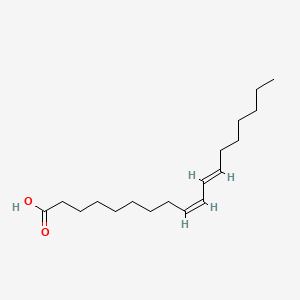
|
Rumenic acid |
Rumenic acid is a lipid of Fatty Acyls (FA) class. Rumenic acid is associated with abnormalities such as Atherosclerosis, Vascular lesions, Hyperlipidemia and Consumption-archaic term for TB. The involved functions are known as Fatty streaks, Transcriptional Activation, Atherogenesis, cholesterol transport and ATP binding. Rumenic acid often locates in Blood and Body tissue. The associated genes with Rumenic acid are ABCA1 gene, apolipoprotein SAA, FATE1 gene and TFCP2 gene. The related lipids are 9,11-linoleic acid, (E,Z)-isomer, 9,11-linoleic acid, Fatty Acids, 11-octadecenoic acid and Total cholesterol. |
324 |
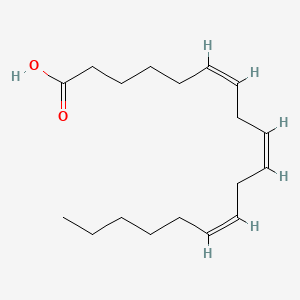
|
gamma-Linolenic acid |
Gamma-linolenic acid is a lipid of Fatty Acyls (FA) class. The involved functions are known as Drug Interactions. Gamma-linolenic acid often locates in Articular system. |
1919 |
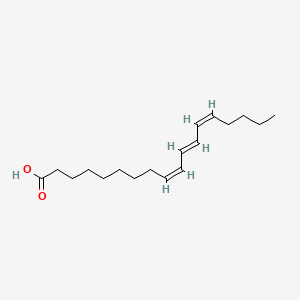
|
Punicic acid |
Punicic acid is a lipid of Fatty Acyls (FA) class. Punicic acid is associated with abnormalities such as Dental caries and Decompression Sickness. The involved functions are known as Anabolism, Binding (Molecular Function), metaplastic cell transformation, Stereochemistry and Oxidants. Punicic acid often locates in Back. The associated genes with Punicic acid are MUT gene, FANCD2 wt Allele, IMPACT gene and SPAG5 gene. The related lipids are Fatty Acids, calendic acid, punicic acid and catalpic acid. |
94 |

|
alpha-linolenic acid |
Alpha-linolenic acid is a lipid of Fatty Acyls (FA) class. Alpha-linolenic acid is associated with abnormalities such as Coronary heart disease, abnormal fragmented structure, Arterial thrombosis and Subarachnoid Hemorrhage. The involved functions are known as Anabolism, Signal, Transcription, Genetic, Saturated and Regulation. Alpha-linolenic acid often locates in Blood, Body tissue, Plasma membrane, Hepatic and peroxisome. The associated genes with alpha-linolenic acid are FATE1 gene, volicitin, CYP2U1 gene, CYP1A2 gene and CYP2J2 gene. The related lipids are Fatty Acids, Dietary Fatty Acid, stearidonic acid and Fatty Acids, Nonesterified. |
4231 |

|
DHA |
Dha is a lipid of Fatty Acyls (FA) class. Dha is associated with abnormalities such as Atherosclerosis, Consumption-archaic term for TB, Chronic disease, Cardiovascular Diseases and Diabetes Mellitus, Non-Insulin-Dependent. The involved functions are known as Inflammation, Oxidation, fatty acid oxidation, Fatty Acid Metabolism and Lipid Metabolism. Dha often locates in Hepatic, Protoplasm, Mucous Membrane, Epithelium and outer membrane. The associated genes with DHA are IMPACT gene, FATE1 gene, GAPDH gene, THOC4 gene and SLC33A1 gene. The related lipids are stearidonic acid, Fatty Acids, Total cholesterol, Lipopolysaccharides and Dietary Fatty Acid. The related experimental models are Mouse Model, Transgenic Model, Animal Disease Models and Arthritis, Experimental. |
11054 |

|
Cholest-5-ene |
Cholest-5-ene is a lipid of Sterol Lipids (ST) class. |
219 |

|
7-octadecynoic acid |
7-octadecynoic acid is a lipid of Fatty Acyls (FA) class. |
8379 |

|
EPA |
Epa is a lipid of Fatty Acyls (FA) class. |
5952 |
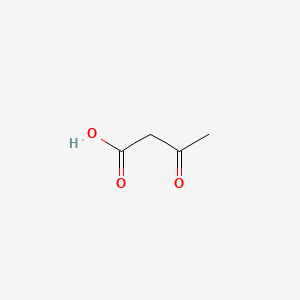
|
Acetoacetic acid |
Acetoacetic acid is a lipid of Fatty Acyls (FA) class.Acetoacetic acid is associated with abnormalities such as Dehydration. The involved functions are known as Biochemical Reaction, intracellular signal transduction, fatty acid elongation, Cytokinesis and Mass-to-Charge Ratio. The associated genes with Acetoacetic acid are CFB gene and mersacidin. Acetoacetic acidis associated with Carbon, Acids, Potassium, Acetoacetic acid and Oximes. The related lipids are Nonesterified Fatty Acids and Stearates. |
2523 |

|
Pyruvic acid |
Pyruvic acid is a lipid of Fatty Acyls (FA) class. |
27047 |
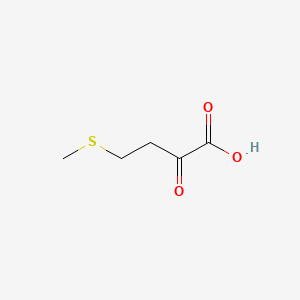
|
4-methylthio-2-oxobutanoic acid |
4-methylthio-2-oxobutanoic acid is a lipid of Fatty Acyls (FA) class. The involved functions are known as polyamine biosynthetic process, Anabolism, enzyme activity, enzyme pathway and Process. The associated genes with 4-methylthio-2-oxobutanoic acid are 2-keto-4-methylthiobutyric acid, MTAP gene, Homologous Gene, 2-keto-4-thiomethylbutyrate and Alleles. The related lipids are alpha-ketocaproic acid. |
289 |

|
6-aminohexanoic acid |
6-aminohexanoic acid is a lipid of Fatty Acyls (FA) class. 6-aminohexanoic acid is associated with abnormalities such as Blood Clot, Myocardial Infarction, Cerebrovascular accident, Renal impairment and Scoliosis, unspecified. The involved functions are known as Fibrinolysis, Agent, Hemorrhage, plasminogen activation and inhibitors. 6-aminohexanoic acid often locates in Chest, Blood, Body tissue, peritoneal and Plasma membrane. The associated genes with 6-aminohexanoic acid are P4HTM gene, BSND gene, MTPN gene, NDUFS4 gene and Homologous Gene. The related lipids are Phosphatidylserines and Butyric Acid. |
3685 |

|
4-aminobutyric acid |
4-aminobutyric acid is a lipid of Fatty Acyls (FA) class. 4-aminobutyric acid is associated with abnormalities such as Epilepsy and Premenstrual syndrome. The involved functions are known as Binding (Molecular Function), neuron survival, Process, Uptake and physiological aspects. 4-aminobutyric acid often locates in Microglial, Neurofilament, Neuraxis, Brain region and Neurites. The associated genes with 4-aminobutyric acid are arginine methyl ester, SLC33A1 gene, NKS1 gene, P4HTM gene and ITSN2 gene. The related lipids are pregnenolone sulfate, pregnane-20-one, Pregnanes, Steroids and endogenous steroids. |
19702 |
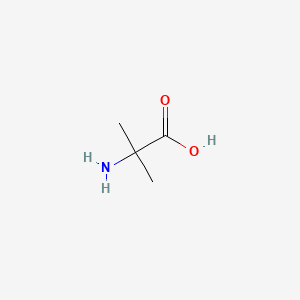
|
2-amino-isobutyric acid |
2-amino-isobutyric acid is a lipid of Fatty Acyls (FA) class. |
1792 |

|
2,5-diaminopentanoic acid |
2,5-diaminopentanoic acid is a lipid of Fatty Acyls (FA) class. The involved functions are known as Vasodilation, Intestinal Absorption and Pinocytosis. 2,5-diaminopentanoic acid often locates in Mitochondria, Microfilaments, NADH dehydrogenase complex and respiratory chain complex III location sensu Eukarya. The associated genes with 2,5-diaminopentanoic acid are GAPDH gene and iberiotoxin. |
8868 |

|
9-hydroxystearic acid |
9-hydroxystearic acid is a lipid of Fatty Acyls (FA) class. |
31 |
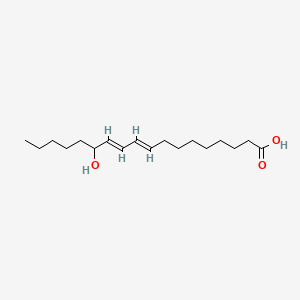
|
alpha-artemisic acid |
Alpha-artemisic acid is a lipid of Fatty Acyls (FA) class. |
448 |
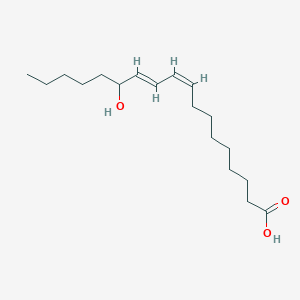
|
Coriolic acid |
Coriolic acid is a lipid of Fatty Acyls (FA) class. The involved functions are known as Autoimmunity, Autoimmune, T-cell differentiation, Binding (Molecular Function) and T-Cell Activation. The associated genes with Coriolic acid are IL2 gene. The related lipids are 9-hydroxy-10,12-octadecadienoic acid, hydroxy fatty acid and octadecadienoic acid. |
326 |

|
29623-28-7 |
29623-28-7 is a lipid of Fatty Acyls (FA) class. |
324 |
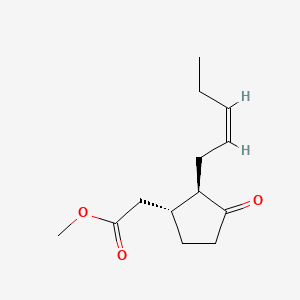
|
Methyl jasmonate |
Methyl jasmonate is a lipid of Fatty Acyls (FA) class. Methyl jasmonate is associated with abnormalities such as Infection, abnormal fragmented structure, Disintegration (morphologic abnormality), Parasitic Diseases and Contracture. The involved functions are known as Stimulus, Signal, Cell Death, Infiltration and Mutation. Methyl jasmonate often locates in Extracellular, Plasma membrane, Cytoplasm, Cell Wall and Body tissue. The associated genes with Methyl jasmonate are Polypeptides, Homologous Gene, NPR1 gene, systemin and Locus. The related lipids are Fatty Acids, Saponins and Oxylipins. |
2442 |
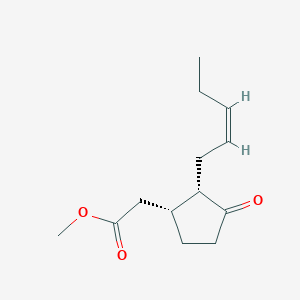
|
Methyl 7-epi-jasmonate |
|
1592 |

|
Prostaglandin E2 |
Prostaglandin E2 is a lipid of Fatty Acyls (FA) class. Prostaglandin e2 is associated with abnormalities such as Renal glomerular disease, Arthritis, Degenerative polyarthritis, Pancreatitis and Rheumatoid Arthritis. The involved functions are known as enzyme pathway, Atherogenesis, Anabolism, inhibitors and Oxidants. Prostaglandin e2 often locates in Tissue membrane, Blood, Extracellular, Membrane and Protoplasm. The associated genes with Prostaglandin E2 are PTGS2 gene, TP53 gene, TNFRSF5 gene, FASTK Gene and TNF gene. The related lipids are Lipopolysaccharides, Steroids, monooxyethylene trimethylolpropane tristearate, Fatty Acids, Unsaturated and Promega. The related experimental models are Arthritis, Adjuvant-Induced, Xenograft Model, Experimental Autoimmune Encephalomyelitis, Cancer Model and Knock-out. |
49278 |

|
PGD2 |
Pgd2 is a lipid of Fatty Acyls (FA) class. Pgd2 is associated with abnormalities such as Inflammatory disorder, Pleurisy, Rhinitis, Dehydration and Pneumonia. The involved functions are known as antagonists, fat cell differentiation, Phosphorylation, Process and Gene Expression. Pgd2 often locates in Cell surface, Body tissue, Extracellular, Bone Marrow and Membrane. The associated genes with PGD2 are oxytocin, 1-desamino-(O-Et-Tyr)(2)-, P4HTM gene, PTGS2 gene, PTGDS gene and IL3 gene. The related lipids are 15-deoxyprostaglandin J2, Nonesterified Fatty Acids, Lipopolysaccharides, Steroids and Liposomes. The related experimental models are Knock-out and Rodent Model. |
6464 |
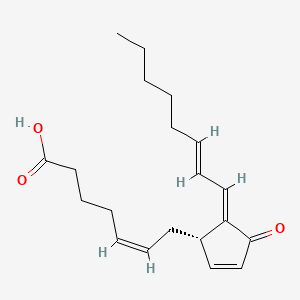
|
15-deoxy-delta-12,14-PGJ2 |
15-deoxy-delta-12,14-pgj2 is a lipid of Fatty Acyls (FA) class. 15-deoxy-delta-12,14-pgj2 is associated with abnormalities such as Dehydration and Myocardial Ischemia. The involved functions are known as Binding (Molecular Function), Inflammation, Alveolar ventilation function, Stimulus and Process. 15-deoxy-delta-12,14-pgj2 often locates in Cytosol, Myocardial tissue and Heart tissue. The associated genes with 15-deoxy-delta-12,14-PGJ2 are Homologous Gene and G-substrate. The related lipids are 15-deoxyprostaglandin J2 and Lipopolysaccharides. |
1201 |
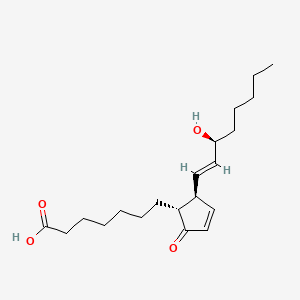
|
PGA1 |
Pga1 is a lipid of Fatty Acyls (FA) class. Pga1 is associated with abnormalities such as Hyperostosis, Diffuse Idiopathic Skeletal, Polyglandular Type I Autoimmune Syndrome and Infection. The involved functions are known as Uptake, inhibitors, Binding (Molecular Function), Denaturation and Adjudication. Pga1 often locates in Extracellular, Plasma membrane, Cytoplasmic, Cytoplasm and Retrobulbar. The associated genes with PGA1 are AIRE gene, synthetic peptide and Recombinant Proteins. |
352 |
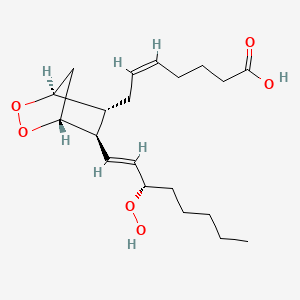
|
PGG2 |
Pgg2 is a lipid of Fatty Acyls (FA) class. |
94 |
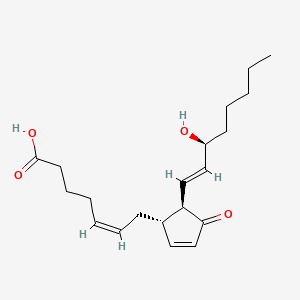
|
Prostaglandin j2 |
Prostaglandin j2 is a lipid of Fatty Acyls (FA) class. The involved functions are known as Apoptosis, inhibitors, Binding (Molecular Function), Protein Overexpression and Cell Proliferation. |
373 |

|
11beta-PGF2 |
11beta-pgf2 is a lipid of Fatty Acyls (FA) class. |
15009 |
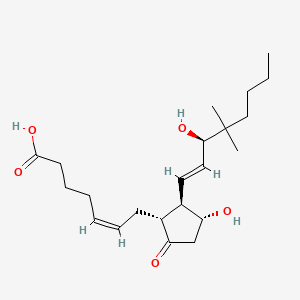
|
16,16-dimethyl-PGE2 |
16,16-dimethyl-pge2 is a lipid of Fatty Acyls (FA) class. |
785 |
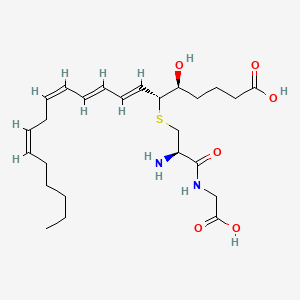
|
LTD4 |
Ltd4 is a lipid of Fatty Acyls (FA) class. Ltd4 is associated with abnormalities such as Inflammatory Bowel Diseases, Inflammatory disorder, Asthma, Pneumonia and Allergic asthma. The involved functions are known as inhibitors, Signal Transduction, Cell Survival, antagonists and Phosphorylation. Ltd4 often locates in Membrane, Tissue membrane, Protoplasm, Cytoplasmic matrix and membrane fraction. The associated genes with LTD4 are ALOX5 gene, UMOD gene, P4HTM gene, RAF1 gene and Homologous Gene. The related lipids are Lipopolysaccharides. |
1167 |
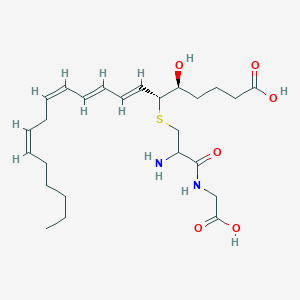
|
Ltd4 |
Ltd4 is a lipid of Fatty Acyls (FA) class. Ltd4 is associated with abnormalities such as Inflammatory Bowel Diseases, Inflammatory disorder, Pneumonia, Asthma and Virus Diseases. The involved functions are known as uptake, Phosphorylation, Signal Transduction, symporter activity and Regulation. Ltd4 often locates in Protoplasm, Mucous Membrane, Membrane, Extracellular and Epithelium. The associated genes with Ltd4 are TYRO3 gene, RAF1 gene, serine-borate complex, ITGAM gene and ITGB2 gene. The related lipids are Lipopolysaccharides. |
201 |
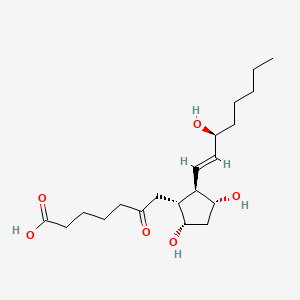
|
6-keto-pgf1alpha |
6-keto-pgf1alpha is a lipid of Fatty Acyls (FA) class. |
3430 |

|
Thromboxane b2 |
Thromboxane b2 is a lipid of Fatty Acyls (FA) class. Thromboxane b2 is associated with abnormalities such as endothelial dysfunction, Diabetes Mellitus, Non-Insulin-Dependent, Diabetes Mellitus, Ischemia and Thrombocytosis. The involved functions are known as Platelet Activation, Excretory function, Anabolism, Inflammation and mRNA Expression. Thromboxane b2 often locates in Endothelium, Hepatic and Microsomes, Liver. The associated genes with Thromboxane b2 are PTGS2 gene, prothrombin fragment 2 and CCL14 wt Allele. |
10175 |
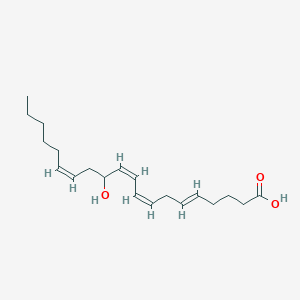
|
12-hete |
12-hete is a lipid of Fatty Acyls (FA) class. |
1452 |
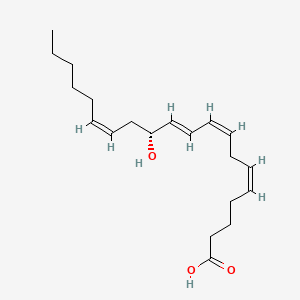
|
12(r)-hete |
12(r)-hete is a lipid of Fatty Acyls (FA) class. |
1079 |
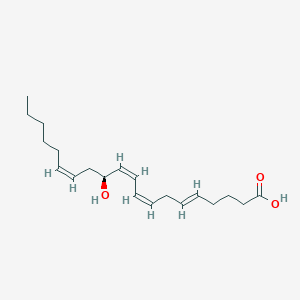
|
12-hydroxyeicosatetraenoic acid |
12-hydroxyeicosatetraenoic acid is a lipid of Fatty Acyls (FA) class. 12-hydroxyeicosatetraenoic acid is associated with abnormalities such as Endothelial dysfunction, Stable angina, Diabetes and Ischemia. The involved functions are known as Inflammation, Protective Agents, inhibitors, Signal Transduction and Extravasation. 12-hydroxyeicosatetraenoic acid often locates in Endothelium, Integumentary system, Articular system, Tissue fiber and Knee. The related lipids are 9-hydroxy-10,12-octadecadienoic acid, 13-hydroperoxy-9,11-octadecadienoic acid, hydroxy fatty acid and DOPE. |
1073 |
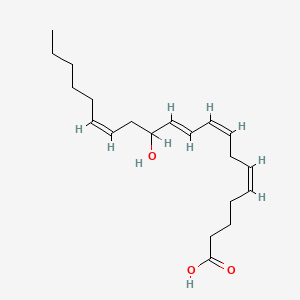
|
12-HETE |
12-HETE is a lipid of Fatty Acyls (FA) class. 12-HETE is associated with abnormalities such as Endothelial dysfunction, Stable angina, Diabetes and Ischemia. The involved functions are known as Inflammation, Protective Agents, Exocytosis, inhibitors and Signal Transduction. 12-HETE often locates in Endothelium, Integumentary system, Articular system, Tissue fiber and Knee. The related lipids are 9-hydroxy-10,12-octadecadienoic acid, 13-hydroperoxy-9,11-octadecadienoic acid, hydroxy fatty acid and DOPE. |
1073 |
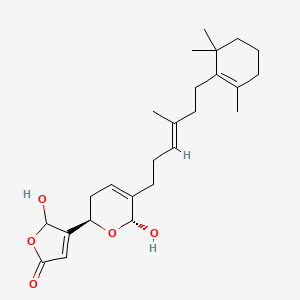
|
Manoalide |
Manoalide is a lipid of Prenol Lipids (PR) class. The involved functions are known as hypotonicity, Cell secretion, membrane invagination, Stimulus and Signal Transduction. Manoalide often locates in Muscle and Myometrial. |
166 |
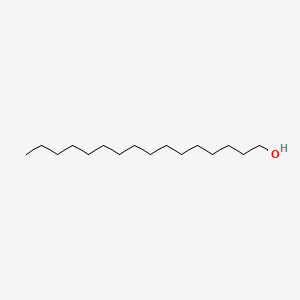
|
Cetyl alcohol |
Cetyl alcohol is a lipid of Fatty Acyls (FA) class. |
511 |

|
4-hydroxynonenal |
4-hydroxynonenal is a lipid of Fatty Acyls (FA) class. 4-hydroxynonenal is associated with abnormalities such as Chronic disease, Obesity, Diabetes, Acquired Immunodeficiency Syndrome and Lung diseases. The involved functions are known as protein expression, Glycolysis, mRNA Expression, Regulation and Mitochondrion in division. 4-hydroxynonenal often locates in Muscle, Mitochondria, Adipose tissue, Head and Mouse Muscle. The associated genes with 4-hydroxynonenal are STAT3 gene, SIRT1 gene, PGC gene, IL6 gene and cytochrome c''. The related lipids are Lipopolysaccharides, Lipid Peroxides, Promega, Membrane Lipids and oxidized lipid. The related experimental models are Mouse Model, Knock-out, Transgenic Model, Disease model and Rodent Model. |
5685 |
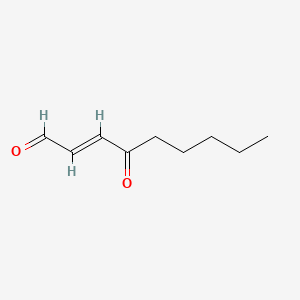
|
4-oxo-nonenal |
4-oxo-nonenal is a lipid of Fatty Acyls (FA) class. The associated genes with 4-oxo-nonenal are TRPA1 gene and oxytocin, 1-desamino-(O-Et-Tyr)(2)-. |
164 |
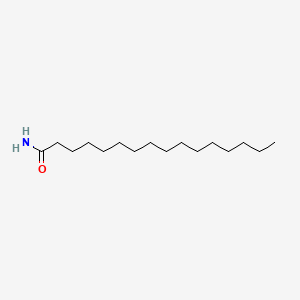
|
Palmitamide |
Palmitamide is a lipid of Fatty Acyls (FA) class. Palmitamide often locates in Membrane. The related lipids are Sterols and Sphingolipids. |
34 |
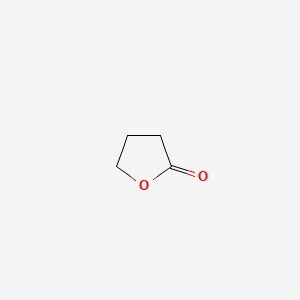
|
Gamma-butyrolactone |
Gamma-butyrolactone is a lipid of Fatty Acyls (FA) class. |
4604 |
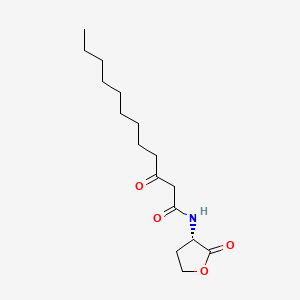
|
168982-69-2 |
168982-69-2 is a lipid of Fatty Acyls (FA) class. 168982-69-2 is associated with abnormalities such as Infection, Bacterial Infections, Cystic Fibrosis, Helminthiasis and Pulmonary Cystic Fibrosis. The involved functions are known as hormone-sensitive lipase activity, Apoptosis, quorum sensing, Signal and Gene Expression. 168982-69-2 often locates in Granulation Tissue, Skin, Dermis, Host Cell and Mouse Skin. The associated genes with 168982-69-2 are ACTC1 gene, PTGS2 gene, CFB gene, LacZ Genes and CELL Gene. The related lipids are rhamnolipid. |
340 |

|
Anandamide |
Anandamide is a lipid of Fatty Acyls (FA) class. Anandamide is associated with abnormalities such as Dehydration. The involved functions are known as Process, Phenomenon, Phosphorylation, Catabolic Process and Gene Expression. Anandamide often locates in Nuchal region, Microglial and Hepatic. The associated genes with Anandamide are SGPL1 gene, SPTLC1 gene, RPSA gene, KDSR gene and SMPD1 gene. The related lipids are Sphingolipids, Lipopolysaccharides, Lysophospholipids, LYSO-PC and lysophosphatidylethanolamine. |
4747 |
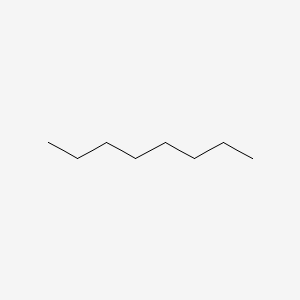
|
Octane |
Octane is a lipid of Fatty Acyls (FA) class. The involved functions are known as enzyme activity and Synthesis. Octane often locates in Mitochondrial matrix. |
2354 |
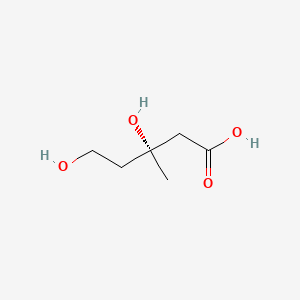
|
Mevalonic acid |
Mevalonic acid is a lipid of Fatty Acyls (FA) class. |
1437 |

|
(e,e,e,e)-squalene |
(e,e,e,e)-squalene is a lipid of Fatty Acyls (FA) class. (e,e,e,e)-squalene is associated with abnormalities such as Hypercholesterolemia and Cataract. The involved functions are known as Process, metaplastic cell transformation, Protein Overexpression, Anabolism and Biosynthetic Pathways. (e,e,e,e)-squalene often locates in Membrane, Protoplasm, Plasma membrane, Tissue membrane and Back. The associated genes with (e,e,e,e)-squalene are Genome, IMPACT gene, GAPDH gene, GTF2I gene and Chromatin. The related lipids are Membrane Lipids, cycloartenol, Sterols, Fatty Acids and Nonesterified Fatty Acids. |
1766 |
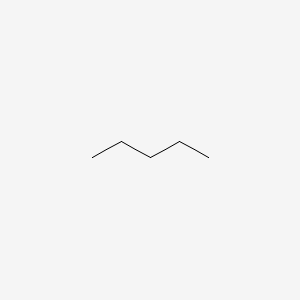
|
Pentane |
Pentane is a lipid of Fatty Acyls (FA) class. |
2265 |
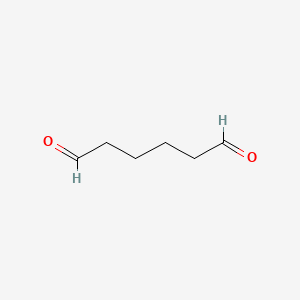
|
Adipaldehyde |
Adipaldehyde is a lipid of Fatty Acyls (FA) class. |
34 |
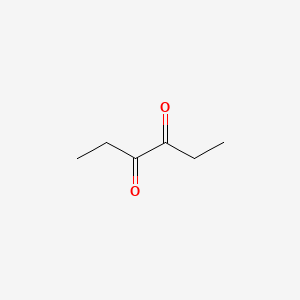
|
3,4-hexanedione |
3,4-hexanedione is a lipid of Fatty Acyls (FA) class. |
9 |
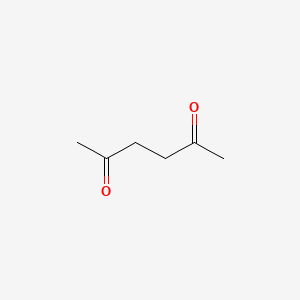
|
2,5-hexanedione |
2,5-hexanedione is a lipid of Fatty Acyls (FA) class. |
646 |
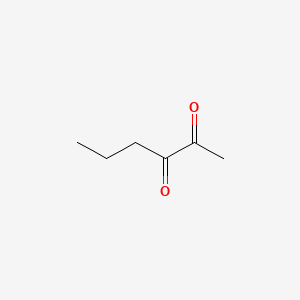
|
2,3-hexanedione |
2,3-hexanedione is a lipid of Fatty Acyls (FA) class. |
33 |
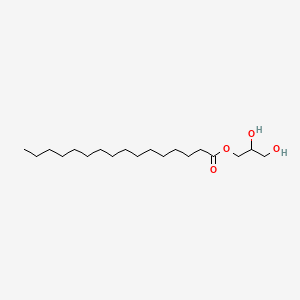
|
1-Palmitoyl-rac-glycerol |
1-Palmitoyl-rac-glycerol is a lipid of Glycerolipids (GL) class. 1-palmitoyl-rac-glycerol is associated with abnormalities such as Eczema, Food Allergy and Fatty Liver. The involved functions are known as inhibitors, lysophospholipase activity, Adjudication, cell transformation and Detergents. 1-palmitoyl-rac-glycerol often locates in Cytosol and soluble fraction. The associated genes with 1-Palmitoyl-rac-glycerol are FASTK Gene. The related lipids are 1,2-oleoylphosphatidylcholine, Lysophospholipids, phenyl valerate, Lysophosphatidylcholines and Palmitates. |
197 |

|
1-Palmitoyl-sn-glycerol |
1-Palmitoyl-sn-glycerol is a lipid of Glycerolipids (GL) class. |
30 |
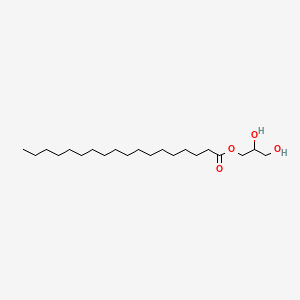
|
Glyceryl monostearate |
Glyceryl monostearate is a lipid of Glycerolipids (GL) class. |
353 |
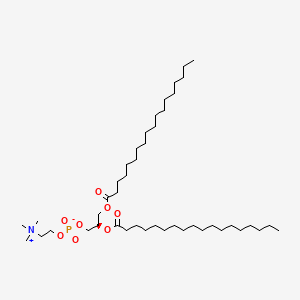
|
816-94-4 |
816-94-4 is a lipid of Glycerophospholipids (GP) class. 816-94-4 is associated with abnormalities such as Gigantism, Pulmonary Hypertension, Neutropenia, Serum Sickness and Urticaria. The involved functions are known as pulmonary effects, Hemodynamics, Stereochemistry, Host defense and Blood Circulation. 816-94-4 often locates in vesicle, Blood, biological membrane, soluble and Cardiopulmonary. The associated genes with 816-94-4 are pentaglobulin, EMILIN1 gene and FASTK Gene. The related lipids are Liposomes, dimyristoylphosphatidylglycerol, Lipopolysaccharides, Unilamellar Liposomes and Unilamellar Vesicles. |
828 |

|
Platelet activating factor |
Platelet activating factor is a lipid of Glycerophospholipids (GP) class. Platelet activating factor is associated with abnormalities such as Atherosclerosis, Acute cholecystitis without calculus, Cholecystitis, Colitis and Cholecystitis, Acute. The involved functions are known as Cell Survival, Metabolic Inhibition, lipid oxidation, Apoptosis and Oxidation. Platelet activating factor often locates in soluble, Cellular Membrane, Smooth muscle (tissue), Intima and Tissue specimen. The associated genes with Platelet activating factor are apolipoprotein A-I Milano, Homologous Gene, TSPO gene, HBEGF gene and SLC33A1 gene. The related lipids are Hydroxycholesterols, Liposomes, 25-hydroxycholesterol, Lysophosphatidylcholines and Lipopolysaccharides. The related experimental models are Knock-out, Mouse Model and Transgenic Model. |
7383 |
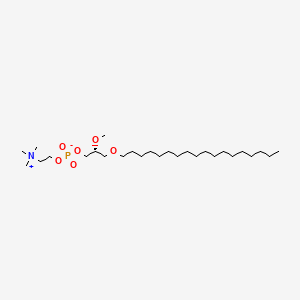
|
ET-18-OCH3 |
ET-18-OCH3 is a lipid of Glycerophospholipids (GP) class. Et-18-och3 is associated with abnormalities such as Morphologically altered structure, Choline Deficiency, Acquired partial lipodystrophy and Punctate inner choroidopathy. The involved functions are known as Mutation, establishment and maintenance of localization, Uptake, Increased Sensitivy and Process. Et-18-och3 often locates in Plasma membrane, Membrane, Back, Protoplasm and Endoplasmic Reticulum. The associated genes with ET-18-OCH3 are Genome, Alleles, ATP8A1 gene, Homologous Gene and ATPase Gene. The related lipids are Phosphatidylserines, Sphingolipids, Lysophosphatidylcholines, Phospholipid Ethers and Phosphatidate. The related experimental models are Knock-out. |
794 |
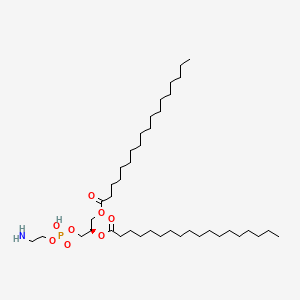
|
1,2-Distearoyl-sn-glycero-3-phosphoethanolamine |
1,2-Distearoyl-sn-glycero-3-phosphoethanolamine is a lipid of Glycerophospholipids (GP) class. 1,2-distearoyl-sn-glycero-3-phosphoethanolamine is associated with abnormalities such as Painful Bladder Syndrome, Dehydration, Renal tubular disorder, Gigantism and Tumor-Associated Vasculature. The involved functions are known as conjugation, Ligand Binding, Process, Laser-generated electromagnetic radiation and Blood Circulation. 1,2-distearoyl-sn-glycero-3-phosphoethanolamine often locates in Tissue membrane, Early endosome, Body tissue, Cell surface and Membrane. The associated genes with 1,2-Distearoyl-sn-glycero-3-phosphoethanolamine are R peptide, P4HTM gene, NHS gene, TSPO gene and SLC33A1 gene. The related lipids are Liposomes, 1,2-distearoylphosphatidylethanolamine, Micelles, Fatty Acids and sialogangliosides. |
438 |

|
1-Oleoyl Lysophosphatidic Acid |
1-Oleoyl Lysophosphatidic Acid is a lipid of Glycerophospholipids (GP) class. 1-oleoyl lysophosphatidic acid is associated with abnormalities such as Myocardial Infarction, early pregnancy, Scleroderma, Blind Vision and Hyperlipidemia. The involved functions are known as Agent, Blood coagulation, Selection, Genetic, Analyte and Biological Processes. 1-oleoyl lysophosphatidic acid often locates in Tissue specimen, Body tissue, Blood, Membrane and Skin. The associated genes with 1-Oleoyl Lysophosphatidic Acid are Mucin-16, Peptides, SMAD4 gene, RND1 gene and Polypeptides. The related lipids are lysophosphatidic acid, A(2)C, Lysophospholipids, Fatty Acids and sphingosine 1-phosphate. The related experimental models are Mouse Model, Knock-out, Cancer Model, Xenograft Model and Arthritis, Adjuvant-Induced. |
3463 |

|
lysophosphatidic acid |
lysophosphatidic acid is a lipid of Glycerophospholipids (GP) class. Lysophosphatidic acid is associated with abnormalities such as Atherosclerosis, Alzheimer's Disease, Asthma, Diabetes Mellitus, Non-Insulin-Dependent and Septicemia. The involved functions are known as Inflammation, Chemotaxis, Binding (Molecular Function), Polymerization and Inflammatory Response. Lysophosphatidic acid often locates in Cytoskeleton, Microfilaments, actin cytoskeleton, Extracellular and Structure of germinal center of lymph node. The associated genes with lysophosphatidic acid are TNF gene, MAPK3 gene, RHOA gene, CDC42 gene and ADRBK1 gene. The related lipids are lysophosphatidic acid, Lipopolysaccharides, Lysophosphatidylcholines, Lysophospholipids and Phosphatidic Acid. The related experimental models are Knock-out, Transgenic Model, Rodent Model and Disease model. |
820 |

|
trichostatin A |
Trichostatin is a lipid of Polyketides (PK) class. Trichostatin is associated with abnormalities such as Dentatorubral-Pallidoluysian Atrophy, PARAGANGLIOMAS 3, abnormal fragmented structure, Disintegration (morphologic abnormality) and Hyperostosis, Diffuse Idiopathic Skeletal. The involved functions are known as Acetylation, Cell Differentiation process, histone modification, Gene Silencing and Transcriptional Activation. Trichostatin often locates in CD41a, Hematopoietic System, Chromatin Structure, Blood and Endothelium. The associated genes with Trichostatin are SPI1 gene, CELL Gene, Chromatin, CXCR4 gene and DNMT1 gene. The related lipids are Butyrates, Promega, butyrate, Lipopolysaccharides and Steroids. The related experimental models are Knock-out, Mouse Model, Xenograft Model and Cancer Model. |
5401 |
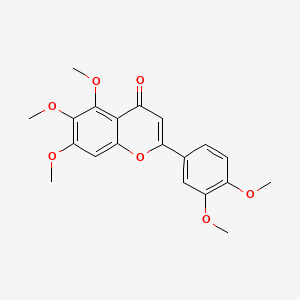
|
Sinensetin |
Sinensetin is a lipid of Polyketides (PK) class. |
76 |
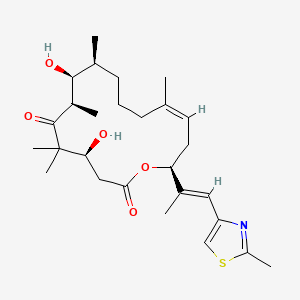
|
Epothilone D |
Epothilone d is a lipid of Polyketides (PK) class. Epothilone d is associated with abnormalities such as Tauopathies, Neutropenia, Neuropathy and Hematological Disease. The involved functions are known as Mutation, Apoptosis, Mitotic arrest, Cell Growth and Anabolism. Epothilone d often locates in Cytoskeleton, Axon, Cell Wall, Chromosomes and Spindle. The associated genes with epothilone D are SLC33A1 gene, Chromatin, GTF2I gene and HEXA gene. |
174 |
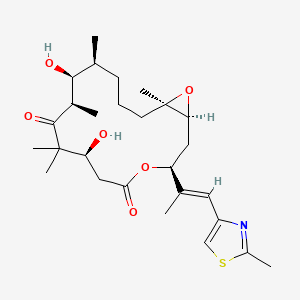
|
Epothilone B |
Epothilone B is a lipid of Polyketides (PK) class. Epothilone b is associated with abnormalities such as Myelosuppression, Measurable Disease, Neuropathy, Neutropenia and Thrombocytopenia. The involved functions are known as Cell Cycle Arrest, Apoptosis, Signal Transduction, Cytokinesis and Caspase Activation. Epothilone b often locates in Mitochondria, Cytoplasmic matrix, Microtubules, Spindle and Protoplasm. The associated genes with Epothilone B are TNFSF10 gene, DIABLO gene, FADD gene, BCL2 gene and BCL2L1 gene. The related lipids are Promega and Phosphatidylserines. The related experimental models are Xenograft Model and Mouse Model. |
492 |

|
tacrolimus |
Tacrolimus is a lipid of Polyketides (PK) class. Tacrolimus is associated with abnormalities such as Renal glomerular disease. The involved functions are known as inhibitors, Fungicidal activity, Metabolic Inhibition, Excretory function and Dephosphorylation. Tacrolimus often locates in Hepatic, Mitochondrial matrix and Inner mitochondrial membrane. The associated genes with Tacrolimus are RHOA gene and BGN gene. |
12730 |

|
ZEARALENONE |
ZEARALENONE is a lipid of Polyketides (PK) class. Zearalenone is associated with abnormalities such as HYPOTRICHOSIS, LOCALIZED, AUTOSOMAL RECESSIVE, 2, Estrogen excess, Food-Drug Interactions, Osteomalacia and Osteoporosis. The involved functions are known as mRNA Expression, Metabolic Inhibition, Phosphorylation, Agent and Transcriptional Activation. Zearalenone often locates in Gastrointestinal tract structure, soluble, viral nucleocapsid location, Spindle and Hepatic. The associated genes with ZEARALENONE are Candidate Disease Gene, Genome, Genes, Reporter, P4HTM gene and Open Reading Frames. The related lipids are Lipopolysaccharides, Steroids, Fatty Acids and Promega. The related experimental models are Transgenic Model. |
2573 |
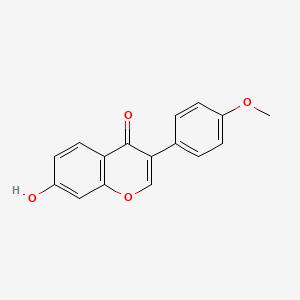
|
formononetin |
Formononetin is a lipid of Polyketides (PK) class. Formononetin is associated with abnormalities such as Infection, Dehydration, Mycoses, Consumption-archaic term for TB and Syndrome. The involved functions are known as Protein Overexpression, Methylation, Esthesia, Anabolism and enzyme activity. Formononetin often locates in soluble, Cytoplasmic matrix, Body tissue, Membrane and Tissue membrane. The associated genes with Formononetin are IMPACT gene, GLUCOSIDASE, Genes, Reporter, IGKV1-16 gene and GAL gene. The related experimental models are Knock-out. |
790 |

|
daidzein |
daidzein is a lipid of Polyketides (PK) class. Daidzein is associated with abnormalities such as Cardiovascular Diseases, Osteoporosis, Heart Diseases, Thyroid Diseases and Exanthema. The involved functions are known as Cell Growth, Disease Progression, metaplastic cell transformation, Cell Cycle and M Phase Cell Cycle Arrest. Daidzein often locates in Urothelium, Mucous Membrane, Chromosomes, Epithelium and Ribosomes. The associated genes with daidzein are Tumor Suppressor Genes, Genome, TIRAP gene, TICAM2 gene and Candidate Disease Gene. The related lipids are Promega, Steroids, Saponins, enterodiol and linoleates. The related experimental models are Xenograft Model, Knock-out, Mouse Model, Breast Cancer Model and Arthritis, Experimental. |
4463 |
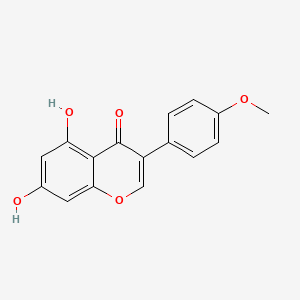
|
biochanin A |
Biochanin a is a lipid of Polyketides (PK) class. Biochanin a is associated with abnormalities such as Osteoporosis. The involved functions are known as Uptake, adenosinetriphosphatase activity, inhibitors, Drug Interactions and Metabolic Inhibition. Biochanin a often locates in Membrane, Tissue membrane, Microsomes, Microsomes, Liver and Entire oral cavity. The associated genes with Biochanin A are CD9 gene, SLCO1B1 gene, ABCG2 gene, EDNRB gene and SPAG8 gene. The related lipids are Steroids, Androstenols, Sphingolipids and 1,2-oleoylphosphatidylcholine. |
465 |
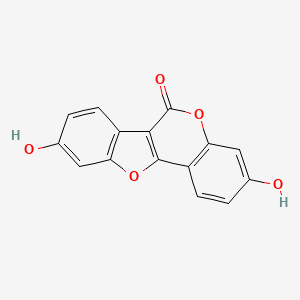
|
COUMESTROL |
COUMESTROL is a lipid of Polyketides (PK) class. Coumestrol is associated with abnormalities such as Infertility, Renal tubular disorder, Osteoporosis, Postmenopausal, Nodule and Central precocious puberty. The involved functions are known as Process, antagonists, Accident due to exposure to weather conditions, physiological aspects and Cell Proliferation. Coumestrol often locates in Blood, Body tissue, Reproductive system, Membrane and Myometrial. The associated genes with COUMESTROL are GAPDH gene, PPID gene, pyridinoline, NODAL gene and Nitrogen fixation gene. The related lipids are enterodiol. The related experimental models are Mouse Model. |
638 |
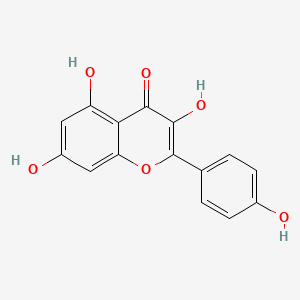
|
kaempferol |
kaempferol is a lipid of Polyketides (PK) class. Kaempferol is associated with abnormalities such as Cardiovascular Diseases, IMMUNE SUPPRESSION, Inflammatory disorder, Dermatitis, Atopic and Asthma. The involved functions are known as enzyme activity, antagonists, DNA Binding, Anabolism and Transcription, Genetic. Kaempferol often locates in aryl hydrocarbon receptor complex, Cytoplasmic matrix, soluble, BL21 and Vacuole. The associated genes with kaempferol are CYP1A1 gene, AHR gene, Genes, Reporter, Candidate Disease Gene and Alleles. The related lipids are Fatty Acids, Steroids, Lipopolysaccharides, Total cholesterol and Palmitates. The related experimental models are Knock-out, Xenograft Model, Breast Cancer Model, Disease model and Animal Disease Models. |
3675 |

|
apigenin |
apigenin is a lipid of Polyketides (PK) class. Apigenin is associated with abnormalities such as Morphologically altered structure, Chimera disorder, Hypertensive disease, infection induced and Infection. The involved functions are known as inhibitors, Gene Expression, Process, Metabolic Inhibition and Cell Death. Apigenin often locates in Vacuole, Cytoplasmic matrix, Cytoplasm, Tissue membrane and Membrane. The associated genes with apigenin are MSMP gene, BCL2 gene, PTGS2 gene, Chromatin and SLC33A1 gene. The related lipids are Lipopolysaccharides, Steroids, 1-Butanol, agosterol A and Butyrates. The related experimental models are Mouse Model, Tissue Model, Knock-out, Xenograft Model and Disease model. |
4250 |
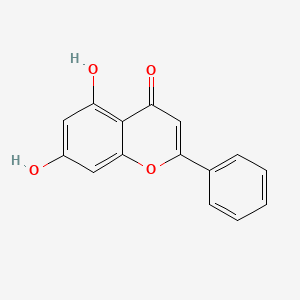
|
chrysin |
chrysin is a lipid of Polyketides (PK) class. Chrysin is associated with abnormalities such as Unconjugated hyperbilirubinemia, Metabolic Diseases, Hypogonadism, Renal tubular disorder and Colitis. The involved functions are known as Hypoxia, enzyme activity, Oxidation, inhibitors and Cell Survival. Chrysin often locates in Protoplasm, Plasma membrane, Back, Extracellular and Mitochondria. The associated genes with chrysin are CFB gene, P4HTM gene, UGT1A9 gene, CYP1A1 gene and UGT1A1 gene. The related lipids are Promega, estradiol-3-glucuronide, Steroids and Lipopolysaccharides. The related experimental models are Mouse Model. |
1085 |
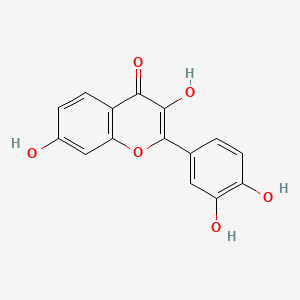
|
Fisetin |
Fisetin is a lipid of Polyketides (PK) class. Fisetin is associated with abnormalities such as Morphologically altered structure, PARKINSON DISEASE, LATE-ONSET, Tetanus, CNS disorder and Disintegration (morphologic abnormality). The involved functions are known as Autophagy, Apoptosis, Energy Metabolism, Acceleration and Anabolism. Fisetin often locates in Mitochondria, Cytoplasmic matrix, Extracellular, Cytoskeletal Filaments and Autophagic vacuole. The associated genes with Fisetin are SIRT1 gene, MAP1LC3A gene, TP53 gene, P4HTM gene and AURKB gene. The related lipids are Phosphatidylserines and Lipopolysaccharides. The related experimental models are Animal Cancer Model, Xenograft Model, Mouse Model, Cancer Model and Disease model. |
832 |

|
Galangin |
Galangin is a lipid of Polyketides (PK) class. Galangin is associated with abnormalities such as Morphologically altered structure and Wiskott-Aldrich Syndrome. The involved functions are known as Apoptosis, Metabolic Inhibition, Cell Proliferation, Process and Proliferation (morphologic abnormality). Galangin often locates in Microsomes, Liver, Cytoplasmic matrix, Microsomes, Protoplasm and Tissue membrane. The associated genes with Galangin are CYP1A1 gene, CYP1A2 gene, WNT3A gene, ALPP gene and TCF7L2 gene. The related lipids are Promega. |
491 |
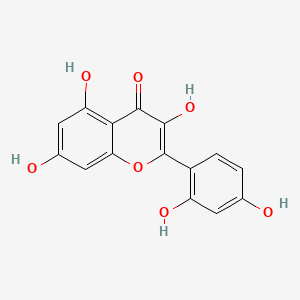
|
morin |
morin is a lipid of Polyketides (PK) class. Morin is associated with abnormalities such as Colitis, Hyperuricemia, Gout, Parkinson Disease and Rheumatoid Arthritis. The involved functions are known as establishment and maintenance of localization, Binding (Molecular Function), Uptake, Increased Sensitivy and Cell Cycle Arrest. Morin often locates in Cell Wall, apoplast, Plasma membrane, Cytoplasmic matrix and Membrane. The associated genes with morin are GADD45A gene, MAPK8 gene, ODAM gene, TNFRSF1A gene and ALPP gene. The related lipids are Lipopolysaccharides, Butyrates, Fatty Acids, Nonesterified, Palmitates and Oleates. |
1499 |
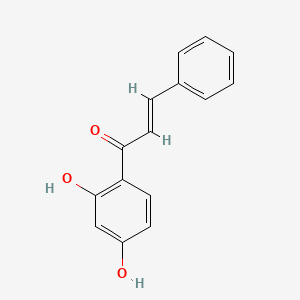
|
2',4'-Dihydroxychalcone |
2',4'-Dihydroxychalcone is a lipid of Polyketides (PK) class. |
43 |
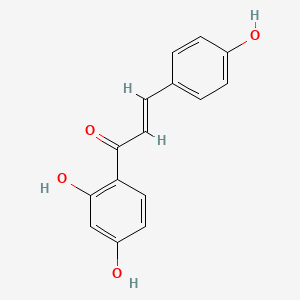
|
isoliquiritigenin |
Isoliquiritigenin is a lipid of Polyketides (PK) class. Isoliquiritigenin is associated with abnormalities such as abnormal fragmented structure, Gastric ulcer, Gastric mucosa lesion, Peptic Ulcer and Wiskott-Aldrich Syndrome. The involved functions are known as Mass-to-Charge Ratio, Anabolism, Oxidation, inhibitors and Energy Absorption. Isoliquiritigenin often locates in Microsomes, Liver, Hepatic, Microsomes, Immune system and Vacuole. The associated genes with Isoliquiritigenin are P4HTM gene, BCL2 gene, AP1AR gene, oxytocin, 1-desamino-(O-Et-Tyr)(2)- and ODAM gene. The related experimental models are Knock-out. |
220 |
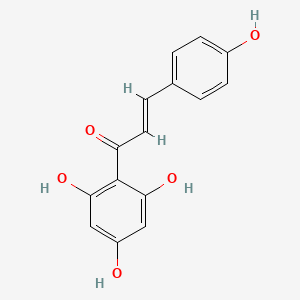
|
naringenin chalcone |
Naringenin chalcone is a lipid of Polyketides (PK) class. Naringenin chalcone is associated with abnormalities such as Dental caries. The involved functions are known as Anabolism, ripening, Localized desquamation, Mutation and gene induction. Naringenin chalcone often locates in Epidermis. The associated genes with Naringenin chalcone are Candidate Disease Gene, Homologous Gene, SLC7A2 gene and CAT 1.6.1. |
57 |
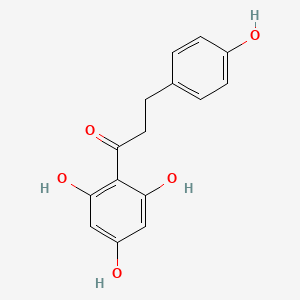
|
phloretin |
phloretin is a lipid of Polyketides (PK) class. Phloretin is associated with abnormalities such as Atherosclerosis, Diabetes Mellitus, Non-Insulin-Dependent, Alkalemia, Renal tubular disorder and pathologic fistula. The involved functions are known as Anabolism, glycosyltransferase activity, Biosynthetic Pathways, Localized desquamation and Biological Processes. Phloretin often locates in soluble, BL21, Cytoplasmic, Extracellular and Cytoplasm. The associated genes with phloretin are Homologous Gene, CD36 gene, Candidate Disease Gene, SLC33A1 gene and PAK1IP1 gene. The related lipids are Liposomes, Palmitates, Fatty Acids, Sterols and 6-ketocholestanol. The related experimental models are Knock-out. |
2367 |

|
emodin |
emodin is a lipid of Polyketides (PK) class. Emodin is associated with abnormalities such as Infection, Conjunctivitis, Vernal, Stevens-Johnson Syndrome, Conjunctival scar and Allergic Conjunctivitis. The involved functions are known as signaling cascade, Metabolic Inhibition, Cell Death, Phosphorylation and JNK Pathway. Emodin often locates in Membrane, Protoplasm, Mitochondria, Cytoplasmic matrix and soluble. The associated genes with emodin are cytochrome c'', UTS2 gene, TK Gene, Gene Clusters and CFC1 gene. The related lipids are Phosphatidylserines, Promega, Sphingolipids, Membrane Lipids and Palmitates. The related experimental models are Mouse Model and Transgenic Model. |
1742 |
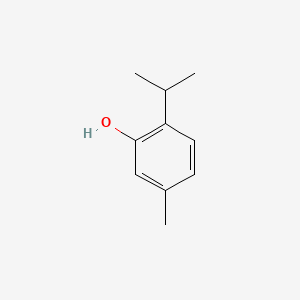
|
Thymol |
Thymol is a lipid of Prenol Lipids (PR) class. Thymol is associated with abnormalities such as Anemia, end organ damage, Dental caries, CLEFT LIP, CONGENITAL HEALED and Wiskott-Aldrich Syndrome. The involved functions are known as synergism, antagonists, Metabolic Inhibition, Pressure- physical agent and Drug Interactions. Thymol often locates in Mucous Membrane, apical membrane, Protoplasm, Extracellular and Serosal. The associated genes with Thymol are HIST1H1C gene, TRPA1 gene, MERTK wt Allele, SLC12A2 gene and TRPV3 gene. The related lipids are Propionate, Pinene, palmitoleic acid, pentadecanoic acid and stearic acid. |
3008 |
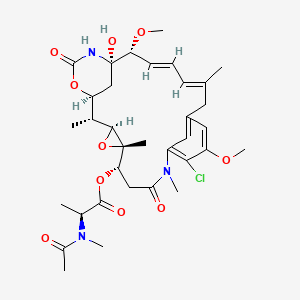
|
MAYTANSINE |
MAYTANSINE is a lipid of Polyketides (PK) class. Maytansine is associated with abnormalities such as Myelosuppression and BOSLEY-SALIH-ALORAINY SYNDROME. The involved functions are known as Mutation, Agent, Polymerization, Cell Cycle Arrest and Drug Kinetics. Maytansine often locates in Cytoplasm, Hepatic, Lysosomes, Cell surface and Microtubules. The associated genes with MAYTANSINE are ABCB1 gene, HM13 gene, CNN1 gene, CYP2C8 gene and CYP2D6 gene. The related lipids are Valerates. The related experimental models are Xenograft Model. |
984 |



































































































